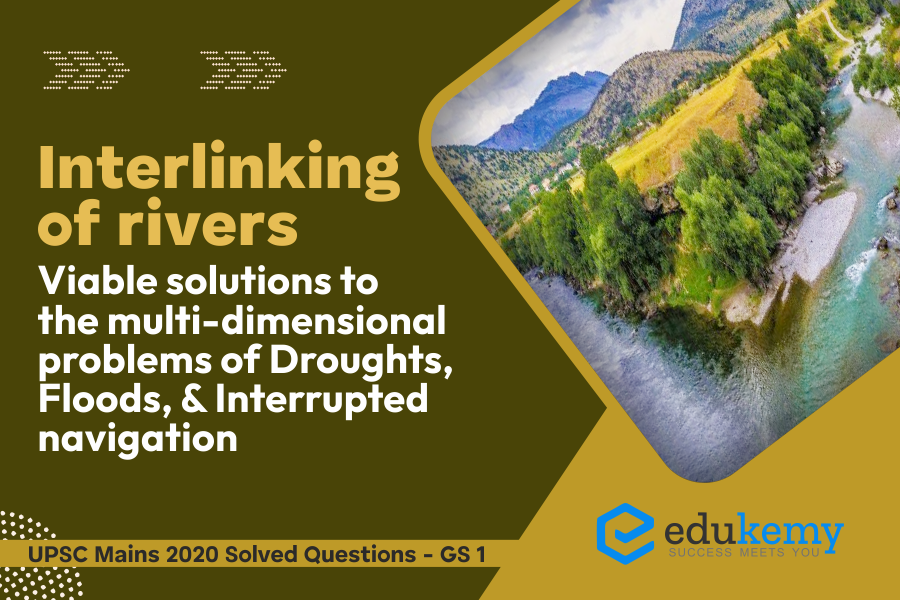The interlinking of rivers stands as a promising strategy to address the multifaceted challenges associated with droughts, floods, and disrupted navigation. By creating an interconnected network of rivers, water resources can be efficiently managed and distributed across regions, mitigating the impact of droughts in water-scarce areas. Simultaneously, excess water during periods of heavy rainfall can be channeled away, curbing the devastating effects of floods. Furthermore, a well-designed interlinking system can facilitate uninterrupted navigation, promoting efficient transportation and trade. This integrated approach not only enhances water availability for agricultural and domestic use but also fosters environmental sustainability. However, it is essential to balance the ecological impact and ensure the equitable distribution of benefits while implementing such projects to achieve long-term success and harmony with nature.
UPSC Mains General Studies Paper – 1 Mains 2020
Distribution of key natural resources across the world (including South Asia and the Indian sub-continent)
UPSC Mains Civil Services IAS Exam Question Paper – 2020
Contents
- 1 Structure of the Question
- 2 Answer
- 3 Conclusion
- 4 Frequently Asked Questions (FAQs)
- 4.1 1. How does interlinking of rivers address the issue of droughts?
- 4.2 2. In what ways does river interlinking contribute to flood control?
- 4.3 3. How does river interlinking enhance navigation along waterways?
- 4.4 4. What are the environmental considerations and potential ecological impacts of river interlinking?
- 4.5 5. How can the interlinking of rivers be implemented on a large scale and what are the associated challenges?
- 5 In case you still have your doubts, contact us on 9811333901.
Structure of the Question
- In Introduction,
- Definition of interlinking of rivers (ILR) and its components.
- In Body,
- Assess the need, Positive and negative side of ILR and elaborate them.
- You can also mention legal and Constitutional provisions in this regard.
- In Conclusion, mention GOI’s various attempts and steps to expedite the project ILR.
Answer
Introduction
Interlinking of rivers envisions transferring water from water ‘surplus’ basins where there is flooding to water ‘deficit’ basins where there is drought/scarcity through inter-basin water transfer projects. The northern plains of India are endowed with surplus water due to the presence of perennial rivers originating from the Himalayas. Southern and western India generally witnesses drought, as this region is drained by seasonal rivers whose water level largely depends on the Indian monsoon. It is designed to ease water shortages in western and southern India and aims to link 30 major rivers.


Benefits of the Interlinking of Rivers
Hydropower Generation:
It would generate additional hydropower, which will help India fulfill its commitment to the Paris Climate Deal. The river interlinking project claims to generate a total power of 34,000 MW (34 GW). It will lead to ground water recharging.
As it would address the low levels of water in southern India’s rivers, it would provide around year waterways connectivity. This will reduce the cost of transportation & levels of pollution and help in economic development.
Irrigation Benefits:
Interlinking of rivers will increase the country’s total irrigation potential, preventing some of the surface runoff into the sea. It will most likely lead to enhanced and expanded irrigation i.e., the project asserts to provide additional irrigation to 35 million hectares in the water-scarce western and peninsular regions.
Employment:
Render employment avenues for more than 10 lakh people for the next decade. The inter-link would generate a path for aquatic ecosystems to migrate from one river to another, which may give livelihoods to the people who depend on the fishery as their income.
Associated Concerns with Interlinking of Rivers
Perennial Rivers Are Not So Perennial:
A new analysis of rainfall data reveals that monsoon shortages grow in river basins with surplus water and falling in those with scarcities.
Federal Issue:
The spirit of federalism is ignored in the river interlinking project.
Historically, there has been dissent on the part of the state governments regarding water sharing. For example, as evident from the ongoing disputes on rivers like Cauvery, Mahadayi.
Tensions with Neighboring Countries:
Bangladesh being a lower riparian state, is less likely to agree to India’s interlinking project. Further, India will be less likely to pressure China on its version of the interlinking river. This will eventually affect lives in north-east India.
High Environmental Cost:
The interlinking of rivers project, which is of a subcontinent magnitude, would harm many ecological factors like delta formation, growth of mangroves, and aquatic life. It will result in huge diversion of forest areas and submergence of land heading to deforestation and soil- erosion. For example, The Ken-Betwa link project lays in danger over 4,100 hectares of forest land or 8% of the Panna National Park)
Economic Cost:
As per Geological Survey of India, this project is of massive, estimated cost, a long-term planning and a sound financial simulation are needed to meet the standard for such proposals. The huge expenditure of the project and the maintenance costs linked with the dams, canals, tunnels, and captive electric power generation will involve huge financial burdens.
Social Costs:
Reconstruction and rehabilitation due to displacement is not an simple task as seen before. The construction of reservoirs and river linking canals in the peninsular component alone are expected to displace more than 5, 83,000 people and submerge large areas of forest, agriculture and non-agriculture land.
Conclusion
Interlinking of rivers has its pros and cons, but given the economic, political, and environmental implications, it may not be a wise decision to carry out this project at a centralized national level. Instead, interlinking of rivers may be pursued in a decentralized manner, and more sustainable ways like rainwater harvesting should be promoted to mitigate floods and droughts. Indeed, it is the need of the hour to have a water mission like IRL, which will enable availability of water to the fields, villages, towns and industries throughout the year post a comprehensive scientific assessment.
Frequently Asked Questions (FAQs)
1. How does interlinking of rivers address the issue of droughts?
Interlinking of rivers involves connecting different river basins to create a network that allows the transfer of water from surplus regions to those facing drought. This process can mitigate the impact of droughts by ensuring a more equitable distribution of water resources, thus helping in sustaining agricultural activities and addressing water scarcity in drought-prone areas.
2. In what ways does river interlinking contribute to flood control?
Interlinking of rivers can help manage floods by diverting excess water from flood-prone regions to areas experiencing water scarcity. The interconnected river system enables better water regulation, reducing the risk of floods in some regions while simultaneously ensuring that surplus water is channeled to regions that need it for irrigation and other purposes.
One of the advantages of river interlinking is the improvement of navigation along waterways. By creating a more consistent and reliable flow of water in interconnected river systems, navigation routes become more predictable and stable. This can enhance transportation efficiency, reduce interruptions, and promote economic activities dependent on water-based transportation.
4. What are the environmental considerations and potential ecological impacts of river interlinking?
While river interlinking aims to address water-related challenges, it is crucial to evaluate its environmental implications. Potential impacts on aquatic ecosystems, biodiversity, and the overall ecology of the interconnected river basins need to be carefully assessed. Understanding and mitigating these potential environmental concerns are essential to ensure sustainable water resource management.
5. How can the interlinking of rivers be implemented on a large scale and what are the associated challenges?
Implementing large-scale river interlinking projects involves intricate planning, coordination, and significant investments in infrastructure. Challenges may include legal and political issues related to water-sharing agreements among states or countries, environmental clearances, displacement of communities, and the overall economic feasibility of the projects. Addressing these challenges requires a comprehensive approach involving various stakeholders and effective governance mechanisms.
In case you still have your doubts, contact us on 9811333901.
For UPSC Prelims Resources, Click here
For Daily Updates and Study Material:
Join our Telegram Channel – Edukemy for IAS
- 1. Learn through Videos – here
- 2. Be Exam Ready by Practicing Daily MCQs – here
- 3. Daily Newsletter – Get all your Current Affairs Covered – here
- 4. Mains Answer Writing Practice – here



